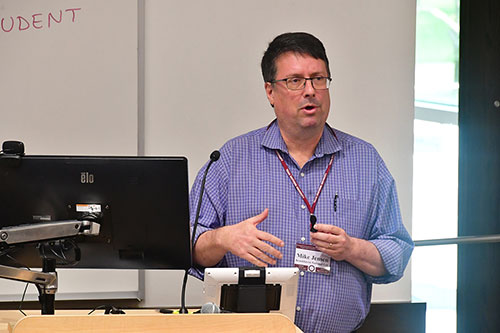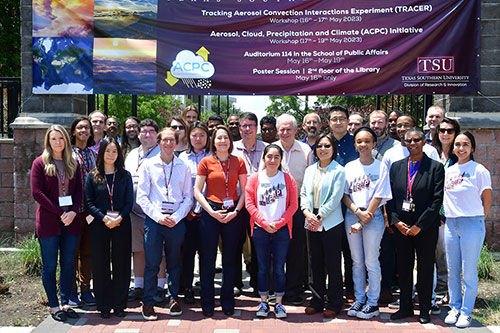Science Workshop Outlines a TRACER Future
Researchers gather in Texas and online to share data, preliminary results, collaborations, and next steps from the Houston-focused ARM campaign
June 29, 2023
By Corydon Ireland, Staff Writer, Pacific Northwest National Laboratory
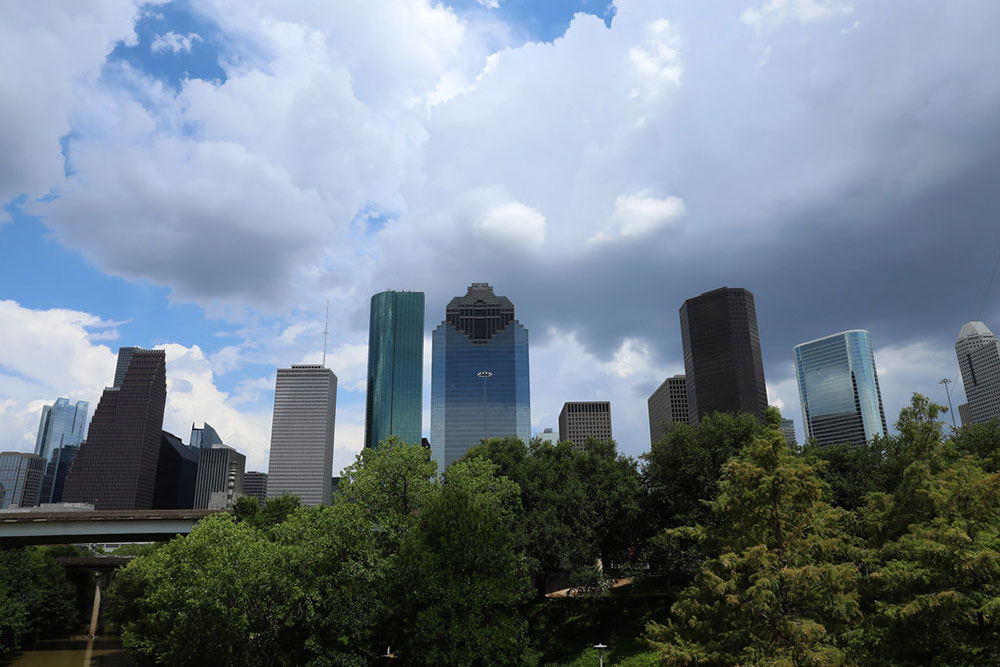 enlarge
enlarge
Houston, Texas, is a city of storms that attracted researchers of deep convection with its mix of aerosol influences from industry, rural landscapes, and sea breezes. (Photo credit: Guy Tubbs)
The following is an excerpt of a story originally published by the U.S. Department of Energy’s Atmospheric Radiation Measurement (ARM) user facility, which is operated by nine DOE national laboratories. Read the full story on the ARM news page.
To gain the most from an atmospheric science field campaign, it is important to reflect on what happened, its meaning, lessons learned, and what remains to be done.
Take TRACER…the TRacking Aerosol Convection interactions ExpeRiment of 2021 and 2022.
In May 2023, TRACER’s lead scientist, Michael Jensen, a meteorologist at Brookhaven National Laboratory in New York, convened a two-day TRACER Science Workshop for researchers to share campaign data, preliminary results, future research plans, and collaborations.
Funded by the U.S. Department of Energy (DOE), TRACER was an international, multi-agency investigation of how storms evolve in coastal Texas.
DOE’s Atmospheric Radiation Measurement (ARM) user facility provided the core instruments for the yearlong campaign.
About 150 field participants from 45 institutions fanned out to more than 10 fixed and mobile observation sites. Those numbers include an array of smaller sister campaigns, which joined this grand coordinated effort to measure the complex alchemy of factors that can affect the formation, growth, intensification, and dissipation of convective systems.
Sister campaigns
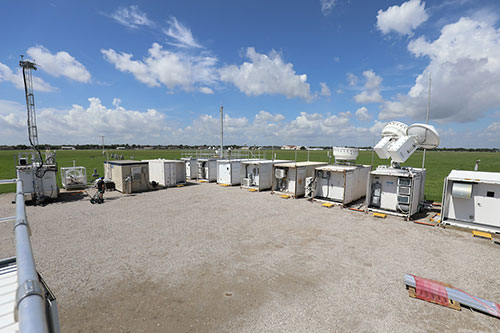 enlarge
enlarge
ARM operated the main site of the TRacking Aerosol Convection interactions ExpeRiment (TRACER) from October 2021 through September 2022 in La Porte, Texas. (Photo credit: ARM)
Researchers from TRACER’s sister campaigns, often from universities and national laboratories, deployed surface instruments, truck-mounted gear, tethered balloon systems, fleets of radiosondes, and uncrewed aerial systems.
During TRACER’s 395 operational days, sounding launches from both the ARM core measurements and these smaller campaigns numbered 1,885.
DOE’s Atmospheric System Research (ASR) program funded many of the sister campaigns. ASR is now funding much of the scientific analysis following TRACER’s field deployment phase.
A major agency partner, NOAA, provided satellite assets, which measured reflected radiation over Houston, and meteorological data from its regional weather stations and coastal buoys.
Meanwhile, the National Science Foundation (NSF), NASA, and the Texas Commission on Environmental Quality oversaw complementary campaigns “at the same time and in the same area,” says Jensen.
Central to it all was famously stormy Houston, with its intriguing regional mix of urban, rural, and marine atmospheric influences.
A workshop’s pause to reflect
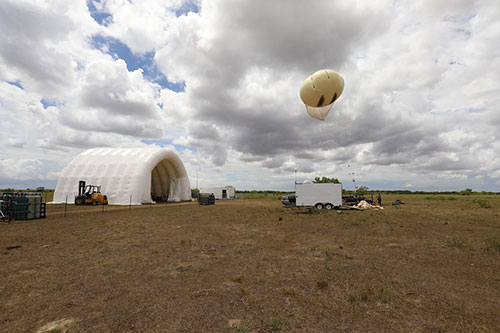 enlarge
enlarge
A tethered balloon system eases into the air during TRACER in August 2022 in Guy, Texas. (Photo credit: ARM)
The May 16–17 TRACER workshop was hosted in Houston by Texas Southern University (TSU), one of the nation’s Historically Black Colleges and Universities.
Faculty and students from TSU’s College of Science, Engineering, and Technology contributed to TRACER measurement activities. They have continued collaborations with science team members on data analysis and modeling activities.
Jensen and others, with TRACER observations tucked into databases, see the campaign as a key to unlocking the puzzle of a worldwide reality of risk: big storms common in coastal cities. Such storms bring needed rain but also periodic floods and other disasters.
During the workshop, about two dozen scientists delivered 10-minute glimpses of their TRACER research. Twenty others showed off their work in a poster session at the TSU library.
Among other topics, presenters touched on storm-affecting aerosols, Gulf of Mexico sea breezes, diurnal cycles of coastal convection, isolated storm cells, new particle formation, and Houston-area lightning strikes.
With aerosols at the forefront of TRACER investigations, Brookhaven Lab’s Maria Zawadowicz took on the basics of what made up these tiny particles in the Houston region. Chemical composition is an important factor in how aerosols interact with water vapor and radiation to influence the life cycle of convective clouds.
The takeaway message, she says, pointing to a paper underway, is “the strong seasonal signal” in the observed aerosol concentrations. Summer air, for instance, is generally cleaner than in other seasons.
Some of those aerosols are linked to mixed black carbon—soot—and dust, according to presenter Allison Aiken of Los Alamos National Laboratory in New Mexico.
She is impressed with the richness of the TRACER data and how exciting intercomparisons will be. Data to consider are black-carbon events at night as well as modeling predictions of dust transported to Texas from the Sahara Desert.
Pavlos Kollias, a Stony Brook University professor and Brookhaven Lab scientist, delivered a look at convective storm-cell tracking. It involved a combination of aircraft, surface observatories, and radar, including a second-generation C-Band Scanning ARM Precipitation Radar in the town of Pearland.
The result of this “most important” NSF-ARM collaboration, he says, was the largest database so far on isolated convective cells. Many were tracked in near-real time thanks to a new algorithm.
On the street, on the water
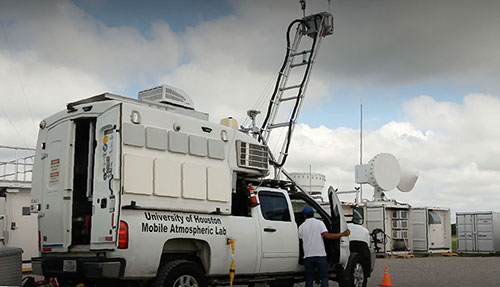 enlarge
enlarge
The University of Houston Mobile Atmospheric Lab, shown here at ARM's main instrument site in La Porte, was among many research vehicles deployed during TRACER to chase storms, aerosol plumes, and evolving clouds. (Credit: Courtesy of the University of Houston)
TRACER co-investigator James Flynn, a research associate professor at the University of Houston, presented an overview of another sister campaign, TRACER-AQ (Air Quality), a joint effort with NASA and the Texas Commission on Environmental Quality.
It was a good example of how smaller-scale, university-based fieldwork, when paired with bigger collaborators, can collect important data from a wide array of low-tech platforms. One main target of TRACER-AQ was ozone, its precursor chemicals, and its photochemical evolution over water.
Flynn directed an observing system that included a quadcopter uncrewed aerial system and other airborne assets, land instruments, equipment mounted on a University of Houston truck, and a mobile air quality laboratory nicknamed “the Baylor trailer.”
He also oversaw ozonesondes launched over water from four small watercraft in 2021 and 2022. About 600 square miles of Galveston Bay, he points out, are normally without any air-quality monitors.
One of the boats will remain in dock as a stationary coastal monitoring site. And a new University of Houston truck-mounted lab may be dispatched in 2024 to supplement ARM instruments at its new Bankhead National Forest observatory in Alabama, slated to open in fall 2023.
Mapping aerosols
Flynn’s air, surface, wheeled, and seaborne research platforms illustrate that TRACER was often a showcase for early career scientists whose instruments hit the road in a variety of ways.
A team led by Rebecca Sheesley, a volatile organic compounds researcher at Baylor University, deployed a mobile air quality laboratory to five sites across the Houston metroplex. One of the sites was an urban forest. Another was next to ARM’s main TRACER site in the Houston suburb of La Porte.
The deployment team included a number of postdoctoral researchers and graduate students who were critical to the success of the campaign.
Sheesley says that the campaign, TRACER-MAP (Mapping Aerosol across Houston), will provide a “more nuanced vision” of air pollutant and aerosol distributions across the city in part a map of how urban and naturally occurring emissions intersect.
TRACER-MAP also has collaboration in mind, says Sheesley. “We want to link the mobile air pollutant and aerosol data with TRACER data sets.”
Following air masses
Milind Sharma, a postdoctoral research associate at Texas A&M University (TAMU), talked about the TRACER-TAMU field campaign, which over 39 days in the summer of 2022 paired an instrument trailer with radiosonde launches.
Researchers measured the variability of regional air masses while sea breezes pushed inland from the coast. They also used radar observations to track storm cells and thunderstorm characteristics.I n this way, says Sharma, the team got “a first look” at taller continental cells as clouds transitioned from shallow to deep.
TAMU graduate research assistant Seth Thompson described another TRACER-TAMU mobile asset: the university’s Rapid Onsite Atmospheric Measurements Van, which tracked maritime and continental air masses over nine days. The van included an aerosol inlet, condensation particle counter, lidar, and [cloud condensation nuclei] CCN counter.
TRACER-TAMU’s lead scientist, Anita Rapp, joined Sharma, Thompson, and others in laying out some preliminary results. Data will add to understanding the vertical distribution of CCN and ice-nucleating particles in air masses associated with deep convection initiated by sea breezes.
Like TRACER-MAP, the TAMU campaign showed the prevalence of early career researchers in a lot of TRACER’s sister-campaign fieldwork.
“Early career scientists were major contributors in every facet of TRACER,” says Jensen, who added “a debt of gratitude for scientific results” that will come from collecting data, contributing to forecasts, and working on data analysis and modeling.
“The experience gained,” he adds, “gives them the foundation to someday lead the next big field campaign.”
Brookhaven National Laboratory is supported by the Office of Science of the U.S. Department of Energy. The Office of Science is the single largest supporter of basic research in the physical sciences in the United States and is working to address some of the most pressing challenges of our time. For more information, please visit science.energy.gov.
Follow @BrookhavenLab on Twitter or find us on Facebook.
2023-21334 | INT/EXT | Newsroom




